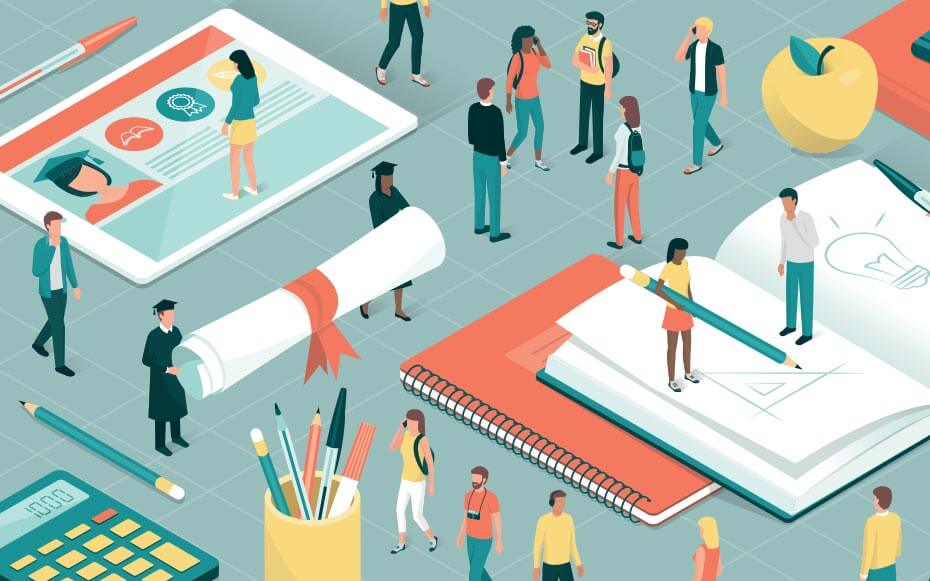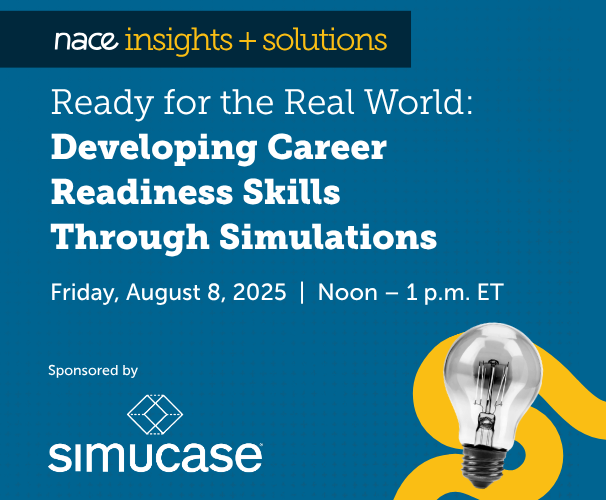Georgia State University’s “College to Career” career readiness initiative was created when Catherine Neiner arrived on campus about seven years ago.
Collecting, analyzing, and acting on data is commonplace at the university. In this case, Neiner, executive director of university career services, and her team validated an unsurprising reality: Most students waited until April of their senior year to think about what they might be doing on the day after they crossed the stage at graduation.
“Immediately, we began discussing strategies for how we could get them started earlier,” Neiner recalls.
“About that same time, our accreditation came up. Georgia State asked for proposals for its Quality Enhancement Plan [QEP]. I submitted a proposal for the career readiness initiative, and it was selected. It essentially became part of our strategic plan.”
College to Career was also a catalyst for securing buy in across campus, and provided a roadmap on how to integrate career readiness university wide. The initiative has three main goals:
- Awareness—From their first year, students learn about their career options. College to Career is built on the NACE Career Readiness Competencies, and students learn about the competencies, how they are defined, how they are demonstrated, and more. Georgia State embedded a College to Career module in its first-year seminar.
- Connection—The initiative helps students connect their coursework with their career goals, pursuits, and objectives.
- Demonstration—Students learn how to show and articulate to employers that they are ready for their careers.
Taking it across campus
College to Career is an institution-wide initiative, which Neiner explains, covers curricular, co-curricular, and extracurricular activities at Georgia State.
“We want students to understand what's happening in their coursework—that's why they're here—and we also want them to understand that working at the grocery store as a cashier also makes them career ready,” she says.
“They are developing career readiness competencies in their part-time jobs and through their involvement in student organizations, their community, their church, the military, and more. We explain to them that this is how they are becoming career ready.”
Tim Renick, Georgia State’s former senior vice president of student success, led the College to Career initiative, while Neiner was the tactician.
“It was also important that Tim and I enlisted the help of a faculty director because this gave us credibility with the faculty,” she points out.
Securing funding and faculty support
College to Career was funded in several ways. First, Georgia State had money for the QEP, which launched and leveraged the initiative. It also, benefitted from several large foundation grants that Renick secured.
“We were fortunate to have several grants to fund some of our most ambitious goals,” Neiner says.
“We are a large state public institution. If we relied on our operating budget, we would not have been able to scale and implement the initiative the way we did.”
The approach focused on engaging faculty, in part and in turn, by offering grants to innovate and promote career readiness. The initiative’s $10,000 College to Career grants were available to faculty and departments to either design a new or reimagine an existing course that applied its coursework to career and career-related activities to give students a better understanding of the connection.
“The work of these Faculty Fellows serves as both an example and a motivation to other faculty,” Neiner says.
Other $500 College to Career mini grants were made possible by a generous donation from a friend of university career services. These grants helped faculty do applied projects that they could not fund through their department operating budget.
“These precipitated some really impactful learnings for students,” Neiner explains.
“All of the grants were vital for us being able to get the faculty to come along. We 100% understood faculty did not want to teach career, so from the get go, we made it clear that we weren’t asking them to teach career; we were asking faculty to help their students understand how what the faculty is already teaching in class makes them career ready.”
The College to Career team supported these efforts by compiling resources on a webpage and, as Neiner explains, “translating career readiness jargon into curriculum-talk.”
She says: “We use terms like ‘project-based learning,’ and ‘pathways’ and ‘learning objectives.’ These are the ways we sold it to the faculty. We anticipated receiving push back and grumbling, but faculty embraced it. It was magic.”
Ensuring equitability
The program also accounted for equity, which was critical because Georgia State is a majority-minority institution with most students first generation and Pell Grant eligible.
“Equity is always, always our first priority,” Neiner says.
“One of the most important things we did was we looked at ourselves, rather than at our students. So often, we hear professionals say that students should be doing this, and the faculty should be doing that. We are educators here and we are a learning lab. At the same time, students don't know what they're supposed to do and when we're saying they should be doing something, it’s like we’re wringing our hands of it and that’s just not helpful. We don’t want to put it all on the student in terms of doing something, or looking and talking a certain way.”
Instead, Neiner and her team considered ways in which faculty and staff could develop students equitably across demographics. This work extended to employer engagement, as well, as the College to Career team brought in its employer partners to explain how to best recruit Georgia State students, offer information about the student population, detail what students do on a day-to-day basis, and more.
“We explained to our employers that traditional methods of recruiting don't work with our students,” she points out.
“We described the ways our students are becoming career ready—such as part-time jobs and being culturally inclusive by virtue of studying at Georgia State. We also explained that, for example, many of our students cannot do a typical internship, which a lot of organizations use as early screens. When employers recruit at Georgia State, we're going to put them in front of a lot of different types of students and this is this is how we suggest that employers interact with our students so they get a fair shot. The bonus is that the employers can recruit excellent students and achieve their diversity goals.”
Boosting the value of on-campus jobs
To ensure that students are building their career readiness skills and understanding “where they are,” Neiner has implemented training for supervisors of student employees on campus.
“Research shows that working on campus is low-hanging fruit for student retention and progression toward graduation,” Beiner says.
“We have a lot a lot of students who work on campus, so we are working not to convert on-campus work to internship equivalence because that's a little tricky, but to set up our on-campus work in a way that helps students in positions throughout campus to develop their career readiness competencies.”
Neiner has created four student assistant training sessions to help supervisors become “first-line career coaches, career mentors, and career advisers” and integrate the career readiness competencies into campus jobs. This program also includes collecting data around career readiness and competency development that will help quantify the effectiveness of the approach.
In all of this work, Neiner stresses the importance of faculty involvement and promotion.
“The College to Career initiative would not work if we were out there just trying to do this by ourselves,” she says.
“Getting faculty buy in, having liaisons in different departments, and having the faculty be our champions was the key. I think everyone on a university campus feels like they have expertise in career, and if you can draw people in and leverage what they have to offer, you can create a culture that is beneficial to your efforts and, ultimately, to all students.”






